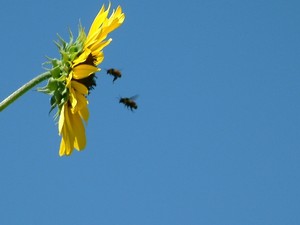04 Feb Wed 2009
adopted chickens
Today we adopted two chickens and one duck from the Stanislaus Animal Shelter. They were brought into the shelter together, and were inseparable friends there even when provided with a huge field and barn to eat and play in. Though we’ve never raised ducks before, we’re glad to give this sweet bird a home with our chickens and geese.
We love raising day-old chicks and goslings, but it is equally rewarding rescuing birds from animal shelters. From a business perspective, adopting older birds can be an advantage by saving us five months (for chickens) or a year (for geese) for the birds to lay eggs. It can also be a risk if you get a sick or too-old bird: chickens stop laying eggs after a few years, and while we don’t mind giving “retired” chickens a home, it is better for business if they earn their keep. Sick birds, of course, can be dangerous to your entire flock, but are typically easy to tell if they are sick. Stressful living situations, such as living at an animal shelter, will tend to exasperate any underlying illnesses so that when you adopt from a shelter you can more easily see if the chicken is sick.
We also just rescued seven two-month old chicks. Their previous owner had raised them (inadvertently) to be cannibalistic. Chickens are curious and omnivorous; when they are young, especially, they will peck at each other for various reasons. If one chick gets injured and bleeds, the other chicks will naturally peck at the blood. If one catches the problem quickly, it is simple to apply a bad tasting ointment to the wound and/or isolate the injured bird until it recovers. Depending on why the bird got injured in the first place, other measures may need to be taken to prevent a reoccurance (for example, fixing a dangerous cage, eliminating overcrowding, or relocating an overly aggressive chick).
The problem with the chicks we bought seems to be that early in their chick-hood they tasted blood and no retraining was undertaken. As a result, they learned to make each other bleed (just a little, on the tailhead) and appear to have been “tasting” each other ever since. Only one of them has a tail; the rest have been pulled out and scabbed over from repeated injury. This is an easy problem to fix, though it would have been better if it had been prevented in the first place. If they had been younger, or if we had no rooster to retrain them, we would have applied bad-tasting ointment to all their tailheads (actively bleeding or not), to teach them that eating tails is gross. Luckily for us, though, we have a good rooster and could take the easier path: we simply put all the chicks in the coop with him and let him teach them how to behave like proper grown up chickens. With a few days of discipline (he never hurts them, just demands obedience), they have all but quit their bad pecking habit.
One of the more challenging parts of adopting chickens is introducing them to the flock. In most cases (excepting situations like the cannibalistic chicks that needed quicker intervention from our rooster) we keep the new chicken(s) in a cage in the coop for a day or two, so that they can introduce themselves without fighting. Then they are let loose in the coop, but all chickens (new and old) are made to stay in the coop for a few days to get well bonded. This is greatly aided by having a good rooster. Skipping this step tends to lead to the new chickens wandering off and getting lost or eaten. Finally, the chickens are let loose like normal to free range around our farm. If the training was successful, they’ll stay together as a flock and return to the coop in the evening. If not, we try locking the flock up for a few more days together in the coop to bond a little more.

